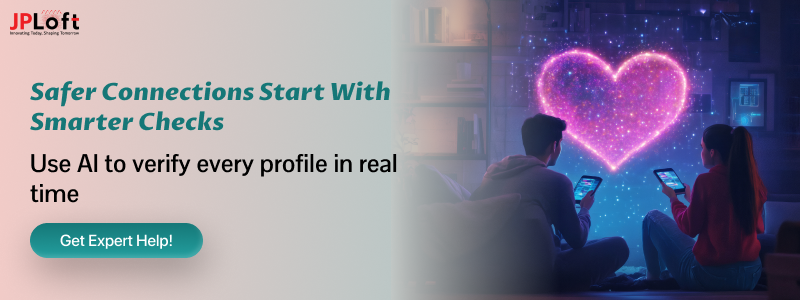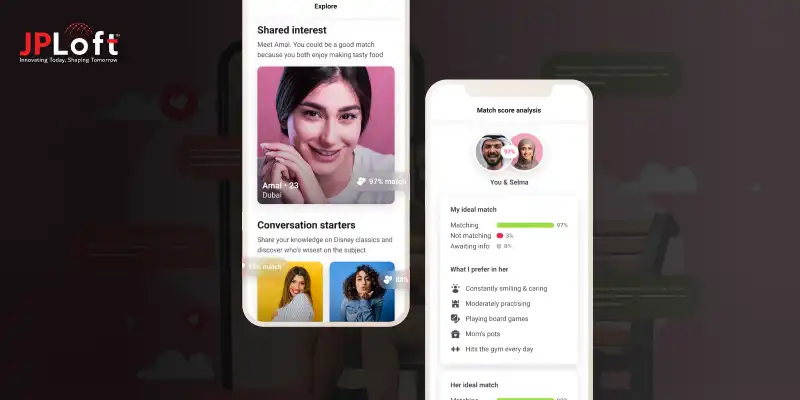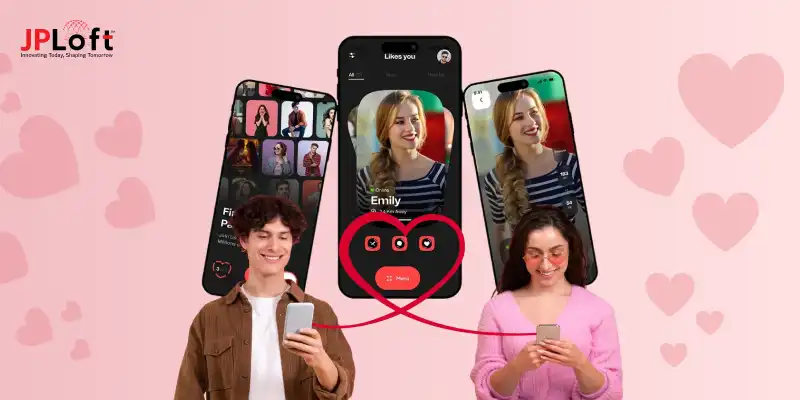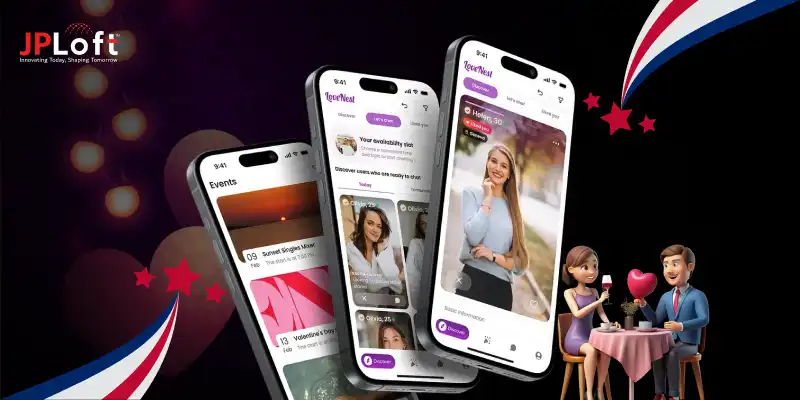“Trust is the glue of life. It’s the most essential ingredient in effective communication.” — Stephen Covey
And there is no room for optional trust in an online dating platform; trust is survival.
When online dating, you swipe and immediately jump into a leap of faith and then for many, that leap is broken over and over again.
According to experts, 85% of dating applications experienced security breaches through their third-party service providers.
An even more troubling aspect of dating platforms is that fake profiles, misleading pictures, and AI-generated deepfakes are rendering traditional verification methods irrelevant.
This will lessen reliance on traditional verification, which diminishes users' confidence and the platform's credibility.
All these factors lead us to a point where Artificial Intelligence becomes a transformative tool. It transforms identity checks into real-time, dynamic, frictionless systems that consider more than just minority threats.
Soon, the landscape could include a commitment from dating apps or platforms to take responsibility for protecting their users and ensuring the safety of the platform itself.
This blog will discuss the benefits and use cases of AI in Dating App Identity Verification.
What is AI-Powered Identity Verification in Dating Apps?
It’s a security process that uses technologies like facial recognition, liveness detection, and behavioral analysis to confirm genuine users, prevent fake profiles, stop fraud, and create safer online dating environments.
AI is much more than a matchmaker in dating apps – it's like a digital bodyguard!
Instead of simply amassing identifiable uploads, AI allows for identity verification through facial recognition, behaviour analytics, and machine learning.
This gives users confidence that they’re signing up with a real identity, not a fake or fraudulent one.
It can identify, for example, edited or doctored photos, recognize bot-like use of the technology, and even recognize suspicious login patterns.
The beauty of it is that after each fraudulent attempt, it learns and improves tirelessly.
This is a crucial advantage for anyone looking to create a dating app that stands out through security.
This enables dating platforms to build trust at scale, offering users safer and trusted alternative spaces to find love and meet like-minded individuals.
For users, it means fewer scams and greater assurance of meeting a real person. For the platform and its investors, it means greater retention and greater differentiation in an industry built on trust and credibility.
How Does AI-Powered Dating Identity Verification Work?
Building a secure online dating app with AI-powered verification isn’t one check at sign-up.
It’s a layered, always-on system that spots fakes, deters fraud, and protects real people. That’s why partnering with an AI app development company is important.
Here’s how each layer works, plus a few extras that make the whole engine harder to beat.
1. Facial Recognition
AI converts faces into numerical “embeddings” and compares a live selfie to the portrait on an ID.
It tolerates glasses, beards, makeup, and angle changes by matching patterns, not pixels. Strong systems:
-
ask for a short selfie video to capture multiple frames,
-
Verify the ID’s authenticity (holograms, fonts, MRZ), and
-
store face templates, not raw images.
Edge cases like twins or heavy cosmetic change trigger a “step-up” check instead of a hard block.
2. Liveness Detection
Liveness answers one question: Is this a live, 3D human in front of the camera?
-
Passive liveness looks for micro-movements, depth cues, light reflections, and camera sensor noise.
-
Active liveness adds prompts: turn your head, blink, read a code.
Modern models spot deepfake artifacts, replayed videos, and screen-to-camera attempts. Good apps adapt difficulty to risk so honest users aren’t punished.
3. Behavioral Analysis
Bots and scammers move differently.
AI learns normal rhythms—swipe speed variance, dwell time, typing cadence, navigation paths—and flags anomalies: copy-paste intros at scale, 24×7 activity, or instant location hops.
This data can be used to refine the dating app matching algorithm, creating better connections.
Text models catch templated scripts and romance-scam patterns.
To stay fair, high scores trigger gentle friction (rate limits, extra selfie) instead of silent bans, and models are tuned to avoid bias against new or infrequent users.
4. Device and Location Checks
Each device leaves a fingerprint: OS signals, sensors, codecs, clock skew, jailbreak/root status, and emulator traces.
Combine that with network and coarse location: IP, ASN, GPS consistency, and VPN/proxy use.
AI flags risky combos—fresh device + aged account, multi-accounting on the same handset, or simultaneous logins from far-apart regions.
Travel happens, so use grace windows and evidence stacking rather than single-signal judgments.
5. Continuous Learning
Every confirmed fraud attempt becomes training data. The system:
-
Monitors model drift.
-
Retrains on new deepfake styles and scam scripts,
-
Runs A/B tests to balance fraud catch vs user friction, and
-
Pipelines human-review outcomes back into the models.
Privacy-preserving options like on-device inference or federated learning reduce data exposure while improving accuracy over time.
6. Risk Scoring And Step-up Verification
All signals roll up into a real-time risk score.
-
Low risk: let users through with light checks.
-
Medium: ask for a fresh selfie or an active liveness prompt.
-
High: require ID + liveness + cooldown, or lock sensitive actions (DMs, payments) until cleared.
This keeps honest users moving and focuses friction where it matters.
7. Human-In-The-Loop (judgment for grey areas)
AI is fast; people are nuanced.
Trust & Safety reviewers audit a sample of passes, handle appeals, and investigate clusters of suspicious accounts.
Clear reviewer rubrics, dual controls for escalations, and audit logs prevent both over-enforcement and blind spots.
8. Privacy, Transparency, and UX (earn trust, don’t demand it)
Tell users what you verify and why.
Keep flows short, explain failures in plain language, and offer quick retries.
Encrypt sensitive data, minimize retention, and allow users to delete verification artifacts when policy permits.
Clear UX turns security into a brand asset, not a hurdle.
Difference Between Conventional vs Intelligent Identity Verification
Traditional verification on dating applications typically doesn't go beyond verifying a user through their driver's license or social accounts.
Although this can provide a level of security and is a starting point, it's just one-dimensional and easily circumvented by fraudsters. Intelligent, AI-based verification grows beyond this.
It uses facial recognition, liveness detection, and behavioral analytics processes to adapt in real time.
This active approach not only verifies identities but also helps mitigate fraud and reduce risk, creating a safer place for users to meet.
At the same time, it gives platforms an opportunity to cultivate the same trust and comfort with their user base as they have done in some of the best dating apps.
|
Aspect |
Conventional Verification |
Intelligent AI-Powered Verification |
|
Process |
Manual ID uploads or social media linking |
Automated AI checks using biometrics & activity data |
|
Accuracy |
Limited, often fooled by fake IDs |
Highly accurate, detects deepfakes & unusual behavior |
|
Adaptability |
Static, doesn’t learn from new threats |
Continuously improves by learning from fraud attempts |
|
User Experience |
Slower, can feel intrusive |
Seamless, often runs in the background |
|
Fraud Resistance |
Vulnerable to stolen or fake credentials |
Multi-layered, harder for fraudsters to bypass |
|
Platform Benefits |
Meets basic compliance |
Builds trust, boosts engagement, lowers fraud costs |
For entrepreneurs and startups, investing in intelligent verification is no longer optional.
Anyone researching the cost to create a dating app will quickly find that AI-driven identity checks are one of the most important features for security, user confidence, and long-term growth.
Common Dating App Scams That Need Your Attention
Do you know that about 53% of men using online dating services reported falling victim to romance scams, compared to 47% of women on the same platforms?
But, now the question is, “What are some common dating app scams?”
Most highlighted ones are scammers using deepfakes, fake verifications, and investment lures. They move you off-app, steal data, and cash out fast.
To go more in-depth, here are some common dating app scams you must know:
1] “Free Verification” Link Scams
Scammers send users fake “verification” pages that look official.
Victims share card details or selfies, fueling identity theft. This pattern is widespread across dating platforms, as reported by the Internet Crime Complaint Center.
Block all off-app verification flows, enforce only in-app signed checks, and use dating app verification with AI technology to bind sessions to devices, preventing spoofed link abuse at the source.
2] Romance-Investment (“Pig-Butchering”) with Fake Brokers
It begins with emotional grooming, often called love bombing.
Scammers then pitch “crypto tutoring,” “liquidity mining,” or shady broker apps. Victims are tricked into massive financial losses.
The CFTC and Internet Crime Complaint Centre warn about these hybrid romance-investment scams.
Platforms can fight back with AI models that flag fast trust jumps, detect sudden off-app movement, and auto-warn users directly in their chats.
3] Deepfake Intimate Extortion At Scale
Attackers now weaponize deepfake technology, forging intimate photos or voice clips from a few selfies. They then demand money, threatening exposure.
Reports from The Guardian, Adelaide Now, and the U.S. Department of Homeland Security show these cases are growing.
Defense requires video liveness checks, AI-powered face-match challenges, rapid in-app crisis routing, and evidence capture for law enforcement before damage escalates.
4] SIM-Swap After Moving to WhatsApp/Telegram
Scammers push victims off-app to WhatsApp or Telegram.
Once there, they hijack numbers using SIM-swap tactics, intercept SMS OTPs, and reset accounts.
Specops Software and Bitsight highlight these rising attacks.
Dating apps must prioritize passkeys over SMS, flag risky carriers, monitor device swaps, and educate users in-thread on spotting SIM-swap attempts before their accounts are taken over.
5] Location Triangulation and Stalking
Dating apps showing “distance” can leak exact locations through triangulation.
Research on “oracle trilateration” proved attackers can pinpoint users to within meters, as noted by Lowyat.NET.
Apps must fuzz distances, snap them to broad grids, rate-limit updates, and audit photo EXIF data or “nearby” carousels for hidden location leaks, protecting users from stalking and offline targeting.
6] 2FA Relay Social Engineering
This scam feels simple: a fraudster asks users to “read out” or forward a code. Once shared, accounts are hijacked.
All About Cookies reports growing 2FA relay abuse. The fix? Train users with in-product prompts to never share codes.
Replace SMS OTP with device-bound tokens, push approvals, and deploy NLP-driven AI to detect suspicious code-asking messages in real time.
7] Fake Dating or “Premium” APKs with Spyware
Fraudsters create clone dating apps or fake “premium unlockers” loaded with malware. Victims sideload these APKs, exposing messages, OTPs, and bank data.
Zimperium, Infosecurity Magazine, and TechRadar report campaigns with hundreds of fake apps.
Platforms should block APK links in DMs, auto-scan outbound messages, and warn users about sideloading risks to stop spyware infections.
8] Data-Leaky Newcomers and Misconfigured Backends
New dating apps often misconfigure servers or expose APIs, leaking private chats, photos, or IDs.
These breaches fuel extortion and blackmail, as shown by Malwarebytes.
To prevent this, companies must run red-team tests, encrypt data at rest, rotate access keys, and monitor for open buckets.
Publishing a clear takedown plan builds trust and mitigates damage when breaches occur.
9] ID Selfie Laundering for New-Account Fraud
Scammers trick users into submitting selfies with IDs for “verification.”
Later, these are reused to open mule accounts elsewhere. Feedzai warns that this is fueling global fraud.
Platforms should secure attestations, enforce liveness checks, and link identity data to device, IP, and behavioural risk.
Blocking raw reuse of selfies helps stop ID laundering before it spreads.
10] QR-Code and Account-Handover Traps
Victims are asked to scan QR codes for “verification” or tiny “fees.” Scammers steal sessions or redirect users to compromised WhatsApp accounts.
This growing trick bypasses traditional filters.
Dating apps should block QR links in chats, auto-warn on suspicious payment discussions, and instead provide safe, native channels for tipping or gifting, keeping financial flows in-app and secure.
Knowing challenges is not enough, so here is how to come out of Artificial Intelligence identity verification in dating apps.
How Does AI-Powered Identity Verification in Dating Apps Help Fight These Challenges?
Like many others, you might be asking, "Can AI actually help reduce these scams?"
Yes. AI-Powered identity verification in dating apps spots fake faces, risky devices, and bot scripts. Video-selfie checks and behavior models block fraud early. That’s how you secure your dating app with Artificial Intelligence.
However, this is not the only benefit; there are several ways that AI-powered identity verification can assist you in overcoming different challenges:
1. Real-Time Photo Authentication
Real-time photo authentication serves as the first line of defense against fraudulent dating profiles.
One of the huge reasons many dating apps fail is due to fake images and stolen photographs that compromise platform integrity and user safety.
This is where AI verification can be of help:
What it does: AI algorithms instantly analyze and compare profile photos with live selfies using computer vision technology to detect fake, manipulated, or stolen images.
How it works: The system examines facial geometry, lighting patterns, image metadata, and compression artifacts while performing reverse image searches to verify photo authenticity and originality.
Benefits: Prevents catfishing, eliminates fake profiles, reduces identity theft, ensures authentic user representation.
2. Biometric Facial Recognition
Biometric facial recognition makes unique digital fingerprints from your facial features.
It allows for better identity checks that keep users profile images and interactions consistent on dating apps using AI technology.
What it does: Advanced facial recognition technology creates unique biometric templates from user photos to verify consistent identity across multiple images and platform interactions.
How it works: Machine learning algorithms map distinctive facial features, bone structure, and geometric characteristics, creating encrypted biometric profiles for accurate identity matching and verification.
Benefits: Eliminates impersonation attempts, ensures profile consistency, & prevents multiple fake accounts.
3. Document Verification Automation
Document verification automation streamlines identity confirmation by instantly authenticating government-issued IDs.
It reduces manual processing time while maintaining high security standards for user verification through AI-powered identity verification in dating apps.
What it does: AI systems automatically scan, analyze, and authenticate government-issued identification documents, including passports, driver's licenses, and national ID cards for verification.
How it works: Optical Character Recognition (OCR) and machine learning verify document authenticity by checking security features, fonts, layouts, watermarks, and cross-referencing with databases.
Benefits: Confirms legal identity, prevents underage access, reduces verification costs, maintains high accuracy rates, ensures regulatory compliance, and streamlines user onboarding processes.
4. Age Verification Protection
Age verification protection helps platforms avoid legal issues and keeps minors safe from inappropriate content.
Advanced identity checks in dating apps with AI technology can accomplish this.
What it does: AI-powered age detection technology analyzes facial features and documents to verify user age compliance with platform policies and legal requirements.
How it works: Facial analysis algorithms estimate age ranges using bone structure and skin analysis while cross-referencing with ID verification for accurate confirmation.
Benefits: Protects minors from inappropriate content, ensures legal compliance, maintains platform reputation, reduces liability risks, and upholds regulatory standards effectively.
5. Veriff AI-Powered Verification Tool
Heard of Veriff- A well-known AI-powered identity verification.
It combines multiple authentication methods to provide robust security for dating platforms.
What it does: Veriff provides enterprise-grade identity verification, combining document authentication, biometric analysis, fraud detection, and global compliance in one integrated platform.
How it works: The platform uses advanced machine learning to verify 11,500+ document types from 230+ countries with sophisticated fraud detection algorithms.
Benefits: Offers scalable verification solutions, reduces fraud by 95%, provides seamless user onboarding, & ensures global compliance.
6. Location Verification Services
By confirming that users are genuinely located where they claim, location verification prevents romance scams and fraud.
This ensures authentic local connections through AI-powered identity verification system in the dating apps.
What it does: GPS-based AI verification ensures that user locations align with their claimed geographic information and profile details, thereby preventing location-based fraud and scams.
How it works: Geolocation APIs cross-reference IP addresses, GPS coordinates, cellular tower data, and user-declared locations for comprehensive consistency verification and validation.
Benefits: Prevents romance scams, ensures authentic local connections, reduces long-distance fraud attempts, & improves matching accuracy.
7. Social Media Cross-Verification
Social media cross-verification helps confirm users' identities by checking their online activity on different platforms.
It makes sure they have a real and consistent presence on dating apps using AI technology.
What it does: AI tools analyze linked social media profiles for consistency, timeline verification, authentic digital footprints, and cross-platform identity confirmation processes.
How it works: APIs scan public social media data, analyzing posting patterns, friend networks, account age, activity timelines, and content consistency indicators.
Benefits: Validates identity across platforms, detects fake social media accounts, provides comprehensive background verification, reduces fraud, and increases user confidence.
8. Voice Authentication Technology
Voice authentication adds an additional security layer by analyzing unique vocal characteristics.
This makes it extremely difficult for fraudsters to impersonate verified users during conversations through artificial intelligence-powered identity verification in dating apps.
What it does: Voice biometric analysis creates unique vocal fingerprints during calls or voice messages for multi-factor identity verification and authentication purposes.
How it works: AI algorithms analyze vocal patterns, speech characteristics, audio frequencies, accent patterns, and speaking rhythms to create distinctive voice profiles.
Benefits: Adds multi-factor authentication, prevents voice spoofing, ensures real-time identity confirmation, and provides a seamless user verification experience.
Removing scams is half the battle- what truly transforms a platform is prevention. That’s where the benefits of AI-powered identity verification systems in dating apps shine.
Benefits of Artificial Intelligence-Powered Identity Verification in Dating Apps
Artificial intelligence is transforming digital dating.
By combining advanced checks with real-time monitoring, platforms can reduce fraud, boost trust, and create safer environments.
If you’re planning to start an online dating business, investing early in identity verification in dating apps via AI technology is the smartest way to stand out and scale.
► Benefits for Users
AI-driven verification makes dating platforms safer and more authentic, giving users confidence to connect without fear of scams or fake profiles.
Find out different advantages of AI-powered verification:
-
Real Profiles Only – The benefits of AI-powered identity verification in dating apps ensure users match with genuine people, eliminating catfish accounts.
-
Enhanced Safety – AI agents scan chats for risky phrases and instantly alert users, reducing chances of romance-investment scams or image-based blackmail.
-
Privacy Control – In Web3 dating app development, users can verify identity without oversharing, keeping personal data secure while still proving authenticity.
-
Faster Onboarding – Video-based checks allow instant verification, meaning users can start chatting sooner without lengthy manual reviews.
-
Trustworthy Connections – Verified badges show who has passed AI checks, making it easier for users to decide who to trust.
► Benefits for Businesses
For dating platforms, strong verification is more than security; it’s a growth strategy.
Apps that secure your online dating app with Artificial Intelligence attract better retention, more subscriptions, and stronger market credibility.
Get to know more benefits of using AI in dating apps:
-
Lower Fraud Costs – AI-driven filters block fraudulent signups early, saving businesses money on manual moderation and chargebacks.
-
User Retention – Safer platforms keep users engaged longer, increasing lifetime value. Apps like Bumble and Hinge thrive because users feel protected.
-
Competitive Edge – Companies adopting dating app identity verification with AI technology gain a trust-based advantage in crowded markets.
-
Scalability – Automated checks verify millions of users quickly, allowing startups to scale without hiring massive moderation teams.
-
Brand Reputation – A secure ecosystem positions your app as reliable, making it easier to partner with payment providers and app stores.
This dual impact– safer user experiences and stronger business growth, shows why AI verification is no longer optional. It’s the foundation of future-ready dating apps.
Real-World Examples of AI-Powered Identity Verification in Dating Apps
Understanding dating apps becomes clearer when we look at how major platforms have implemented AI-driven identity verification.
These examples highlight both struggles and solutions, and they’re highly relevant for anyone aiming to build something of their own, where trust and safety are crucial to user adoption.
A] Tinder's Photo Verification Revolution
When considering how to create an app like Tinder, understanding their AI-powered photo verification is important.
Tinder's photo-replication technology requires users to mimic specific gestures in real-time selfies, reducing fake accounts by 40%.
However, false rejections affecting users with disabilities created accessibility challenges, requiring continuous algorithm refinement to balance security with inclusive design principles.
B] Bumble's Liveness Detection Success
For those planning to develop an app like Bumble, their AI-based liveness detection offers compelling insights.
Bumble analyzes micro-movements, eye blinking, and facial expressions during signup, blocking 60% of catfishing attempts.
Despite effectiveness, user privacy concerns regarding biometric data storage required transparent communication about data handling and strict retention policies to maintain confidence.
C] Grindr's Message Filtering Innovation
Entrepreneurs looking to build an app like Grindr should examine their AI message filtering system.
Grindr’s natural language processing scans conversations for harmful phrases and scam indicators, reducing fraud by 55%.
However, evolving deepfake threats and social engineering tactics require continuous AI model retraining, demanding dedicated machine learning teams and substantial ongoing investment.
D] Hinge's Predictive Safety Alerts
Those interested in knowing how to make an app like Hinge can learn from their predictive AI safety system.
Hinge’s matching algorithm works differently; it basically alerts users about risky messages, including money requests and manipulation tactics.
This improved safety scores by 45% and retention rates, though it required significant investment in behavioral psychology research and user experience design.
These real-world examples show that for platforms aspiring to become the best dating apps in Dubai or globally, AI verification is not just a feature- it’s a foundation for building safer, trusted communities.
As we laid the foundation of real-world examples, it's time to know about the challenges in implementing AI technology in identity verification.
Challenges in Implementing AI-Powered Identity Verification in Dating Apps
Adopting AI for verification in dating apps is powerful but complex.
Many founders ask, "What are some challenges in implementing AI-powered identity verification system in dating apps?"
The truth is, these systems bring unique hurdles that affect privacy, compliance, and user trust.
Below, we’ve broken down the biggest dating app challenges and practical solutions to overcome them.
Challenge 1: Privacy Concerns and User Trust
Users hesitate to share ID scans or video selfies, fearing misuse of sensitive data. This is especially critical in regions with strict privacy expectations
Solution: Be transparent about storage policies, encrypt data at rest, and use decentralized options like Web3 dating app development to give users more control.
Challenge 2: High Costs of Deployment
Advanced AI, biometric checks, and fraud databases are expensive to integrate, especially for startups.
Solution: Start with scalable APIs from providers like Veriff or Onfido. They allow pay-as-you-grow pricing, ensuring smaller apps can integrate strong identity checks without heavy upfront investment.
Challenge 3: Compliance with Global Regulations
Laws like GDPR and CCPA complicate cross-border identity verification. Different regions demand different standards.
Solution: Build modular verification flows. For example, EU users can go through GDPR-compliant data paths, while US users follow CCPA rules. This reduces legal risks.
Challenge 4; False Positives and User Friction
AI models can wrongly reject genuine users, causing frustration and churn. A strict onboarding flow risks blocking real matches.
Solution: Use layered systems– combine quick selfie checks with passive signals like device fingerprinting. This lowers false rejections while still filtering fraud.
Challenge 5: Adapting to Evolving Scam Tactics
Scammers use deepfakes, synthetic IDs, and bot-driven chats to bypass static verification. These methods evolve quickly.
Solution: Retrain AI models continuously. Adding AI agents in Dating Apps helps monitor real-time conversations, flagging new fraud behaviors and keeping the system adaptive.
Challenge 6: Technical Integration with Legacy Systems
Older apps or startups with limited backend infrastructure struggle to integrate complex AI verification pipelines.
Solution: Partner with experienced mobile app development companies like JPLoft that specialize in dating platforms. They can integrate AI-powered systems smoothly while ensuring scalability.
Challenges being clear, we are about to get into the future of AI-powered dating apps.
What is the Future of AI-Powered Dating Identity Verification?
The future of identity checks in dating apps is shifting toward smarter, more transparent systems.
From AI-driven liveness detection to blockchain-backed IDs, the next generation of verification will reshape trust online.
As future trends in dating apps evolve, platforms will need to adopt solutions that are scalable, privacy-first, and globally compliant.
Key directions shaping the future of AI-powered dating identity verification:
-
AI-driven liveness detection – Real-time video prompts that stop deepfakes and synthetic IDs from passing verification.
-
Behavioral biometrics – Typing speed, swiping rhythm, and device patterns add a passive layer of security without disrupting user experience.
-
Web3 digital identity wallets – Blockchain-backed IDs allow users to prove authenticity while controlling their personal data, reducing privacy concerns.
-
Global compliance automation – AI-powered workflows that adjust automatically to regional laws like GDPR, CCPA, or local UAE data standards.
-
Continuous, invisible verification – Instead of one-time checks, AI agents monitor profiles and conversations to prevent fraud mid-interaction.
-
User-first verification UX – Onboarding will become frictionless with instant selfie-video checks, boosting adoption rates without frustrating real users.
-
Cross-platform trust portability – Verified IDs may be used across multiple platforms, letting users carry trust wherever they connect.
The future isn’t just about blocking scams; it’s about turning verification into a feature users value. Dating apps that embrace these innovations will stay ahead in a highly competitive market.
How Can JPLoft Help You Integrate AI-enabled Identity Verification in Dating Apps?
Imagine starting a dating app where every profile is real, every match is trusted, and scams are stopped in their tracks.
That is what AI-enabled identity verification can do for you, and that is what JPLoft does.
As the top dating app development company, we have the experience in combining security with seamless experiences.
Suppose you are a startup, a national franchise or anywhere in between- we have the experience creating successful platforms like Machha, TruuBlue, and so many more.
Our team knows how to create apps to scale, protect, and engage users. Working with JPLoft provides an opportunity to create a platform that users can trust, while standing out in an increasingly competitive dating sector!
Conclusion
Trust is the key currency for the dating industry. As fake profiles, deepfakes, and scams become more prevalent, there isn't enough traditional vetting.
That is where AI-powered Identity verification in dating Apps will help. By offering biometric checks, liveness detection, behavioural analytics, and using solutions like Veriff, the user base on apps can be safeguarded, while the apps can foster long-term trust.
For users, this is a safer way to connect; for businesses, better retention and monetization potential.
The future of dating will be geared toward apps that offer security, transparency, and innovation -- making AI not just a component but the reason for a new evolution of online dating experience.
FAQs
AI automatically verifies users by using selfies, government IDs, and liveness indicators to automatically verify users, identify deepfakes, detect and flag suspicious user behaviours, and block bots. Increasing security measures make online dating identity verification increasingly fast, intelligent, and trusted.
Backlash against invasive privacy-enabled AI, the costs of implementing, false positives, and evolving scams constitute some of the challenges confronting using AI and identity verification in dating apps. Options like Veriff, behavioural biometrics, and AI-based liveness testing can help dating apps with these challenges while ensuring both user safety and user experience are maintained.
AI-based online dating identity verification employs multi-layered systems of document scanning, biometric matching, device fingerprinting, and behaviour monitoring. AI combines signals into a risk score, making sure genuine profiles pass, while fake fraudulent profiles are denied in real-time.
The advantages of AI-based identity verification in dating apps are safer matches, reduced catfishing, greater trust, and enhanced brand reputation. Platforms experience reduced fraud costs, improve retention rates, and encourage additional monetization opportunities with premium safety features.
Dating platforms can secure your online dating verification by combining AI powered liveness detection, document verification, and ongoing behavioral monitoring. This allows them to determine that every new signup and every interaction is real and helps to create trusted experiences at scale.













Share this blog